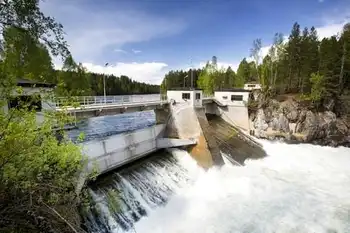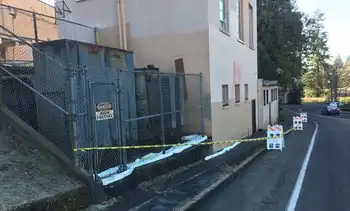An ugly battle over clean power
ELLENSBURG, WASHINGTON - The wind blows so hard over these desert ridges that it topples outhouses. It whistles through the high steel towers strung with cables that carry electricity west to light the cities of Puget Sound.
The hills west of Ellensburg, then, would seem an ideal spot for giant wind turbines to help quench the Northwest's thirst for clean, home-grown energy. Instead, they have become a battleground as Kittitas County officials and some locals square off against environmentalists and wind-power companies over putting towering generators near rural homes that dot these hills and valleys. Now the five-year-old debate has reached all the way to the governor's office, elevating this beyond a classic not-in-my-backyard tale in a sparsely populated county. The outcome of this fight could set a precedent for future fights over wind power in the state as demand continues to mount. "There are going to be sites that aren't out in the middle of wheat fields anymore," said Dana Peck of Horizon Wind Energy of Houston, one of two companies seeking to build dozens of the turbines here. "It wouldn't be allowed in King County," counters Rick Forster, a Redmond man who owns a vacation cabin nearby. "But they just figure in this little county over there it doesn't matter." New popularity If Horizon gets its way, its Kittitas Valley Wind Power project will erect 65 wind turbines with poles the size of old-growth firs and propeller blades up to 145 feet long. They would line ridges on either side of Highway 97 outside of Ellensburg. Another company, California-based enXco, wants to build an additional 90 in the same area under the name Desert Claim Wind Power. All told, they could produce enough power to light roughly 100,000 homes. Wind turbines have become popular in the Northwest lately, thanks to the current worry about global warming and to recent government subsidies and mandates. Last year, Washington voters passed a law requiring major utilities in the state to get 15 percent of their power from renewable sources by 2020, and big dams don't count. Much of it is expected to come from wind power. California and Oregon have even more aggressive targets.
There are 42 wind-power projects in the works in Washington, Oregon and Idaho, more than double the number already running, according to the Renewable Northwest Project, an alliance of energy companies and environmental groups. Kittitas County already has 127 massive wind turbines. The Wild Horse project, on the flanks of Whisky Dick Mountain east of town, is visible from Ellensburg. But there are hardly any homes near it, so it's been warmly received by locals. Not so for the Horizon and enXco proposals. Gov. Christine Gregoire sidestepped a final decision on allowing the Horizon project.
Instead, she asked a state agency, the Energy Facility Site Evaluation Council (EFSEC), to look for a way to build the turbines farther from homes while keeping the project economically viable. It's unlikely to end the feud. "This is not the place" Sandy Sandall can't see how to make dozens of 410-foot-tall wind turbines palatable, even if they're a mile or more from his back deck. The retired Boeing mechanic moved into a log home on a forested ridge in 1997. He had discovered the spot while elk hunting, and was charmed by the quiet and the view. Now it looks down on the proposed Horizon wind farm.
Sandall says he doesn't oppose wind power. He gets his electricity from solar panels and from his own relatively tiny wind turbine mounted on a 50-foot pole. But rows of white massive white poles, topped with blinking lights and propeller blades that make a "whoosh" audible from several hundred yards away – that's another thing. Sandall remains unconvinced by assurances that the sound won't be noticeable from farther off, and that it won't hurt property values. "I'm 72 years old. I came out here to be alone," said Sandall, who is part of a citizen group, Residents Opposed to Kittitas Turbines.
"I have no objection to alternative energy. This is just not the place." With such concerns from the neighbors, the three-member Kittitas County Commission rejected the enXco plan in 2005 and Horizon's in 2006. There are signs of displeasure elsewhere in the region. Last month in Columbia County, where several wind projects have already been built, a group of landowners challenged yet another project. In Oregon, a proposal for turbines near the Columbia River Gorge prompted a call in May for a moratorium on all new wind farms in the state while officials sort out how to regulate them. But not everyone in Kittitas County is against the turbines.
Mike Genson, a retired local schoolteacher, owns 420 acres below Sandall's house. He's agreed to let Horizon build seven turbines on the land. Genson, 67, said he was skeptical when the company first approached him. But he visited another wind-power project near Walla Walla and didn't mind the way it looked or sounded. Besides, Genson said, he likes the idea of providing clean power. And the income – possibly $30,000 a year or more – could allow him to keep the property, where he lives part time. "If we don't get the wind farm, we're going to be forced into gradually letting this go to development," he said. The governor's dilemma In the meantime, the fight has produced some unusual alliances. Both environmentalists and business groups, including Kittitas Valley's economic-development organization, are backing Horizon's bid. They urged the Energy Facility Site Evaluation Council to reject the county commission's denial of the project. "The fact that someone doesn't like the looks of a wind turbine, I have some sympathy for them," said Sara Patton, executive director of the NW Energy Coalition, a Seattle group. "But that's just not as important as dealing with the climate and our air. EFSEC voted to let the Horizon project go ahead. Now, enXco plans to ask for a similar ruling. Though Gregoire has asked EFSEC to do more work on its Horizon recommendation, the final decision rests with her. Kittitas County officials have been urging her to reject the EFSEC ruling. Darryl Piercy, head of the county's Community Development Services department, said it's a test of whether local development decisions will be honored by the state. "This is troubling to think that that local process can easily be ignored," he said. Gregoire simply said that she was trying to weigh the concerns of local officials against the region's need for more clean power.
"I am very mindful of the cumulative impact of wind power projects in Kittitas County and will continue to evaluate this issue," she wrote.
Related News

New energy projects seek to lower electricity costs in Southeast Alaska
ANCHORAGE - New projects are under development throughout the region to help reduce energy costs for Southeast Alaska residents. A panel presented some of those during last week’s Southeast Conference annual fall meeting in Ketchikan.
Jodi Mitchell is with Inside Passage Electric Cooperative, which is working on the Gunnuk Creek hydroelectric project for Kake. IPEC is a non-profit, she said, with the goal of reducing electric rates for its members.
The Gunnuk Creek project will be built at an existing dam.
“The benefits for the project will be, of course, renewable energy for Kake. And we estimate it will save about 6.2 million…




